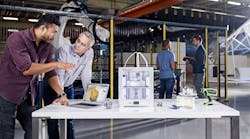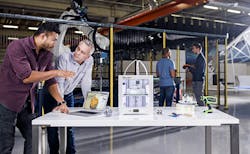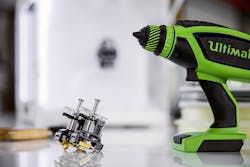The ability for enterprise employees to produce a small replacement part, create a prototype, or develop a usable product via a 3D printer directly at their desks was historically viewed as a hopeful wish, yet unattainable due to cost and physical printing restrictions. Until recently, most professional users would, justifiably, dismiss desktop printing due to machine and part quality.
However, recent innovations and increased accessibility within the market have made the notion of desktop 3D printing a reality that’s completely changing the way many businesses work—revolutionizing productivity and workflow. In fact, we’re fresh out of the AMUG Conference and the Rapid-TCT shows and noticed a common theme during our conversations: The professional additive-manufacturing crowd is adopting desktop 3D printers more than ever before—not just for prototyping, but also for tooling.
Innovation in desktop 3D printing has made the technology vastly more accessible in the professional environment, enabling businesses and educational institutions to quickly and cost-effectively print with industrial-grade materials.
So what is it about the desktop printer versus traditional room-sized industrial machines that’s catching on in enterprises across industries? We’re already seeing these desktop machines displacing 3D-printing systems that cost tens of thousands of dollars. U.K.-based market research firm CONTEXT found that the sub-$5,000 personal/desktop 3D-printer category, representing the major part of total units sold, grew +15% year-over-year in the first half of 2016.
Let’s explore the case for the desktop 3D printer and how these machines will impact the workplace moving forward.
Innovations Leading to Change
The pace of improvement and change with desktop 3D printers has been much faster than historical technical growth in the industry. The period between 1990 and 2010 is when 3D printing was invented and the first companies established a market presence. However, since 2010, expiration of patents, a greater public awareness, more competition, and freer access to capital has brought a large number of new companies into the space, accelerating innovation like never before.
Growth and innovation in desktop 3D printing has meant that enterprises can not only print prototype parts, but also jigs, tools, and fixtures with ease.
Innovations in technical capability—including increases in quality and reliability—are putting desktop printers on par with industrial printers. At the same time, costs continue to decline, making desktop printers even more predominant across businesses and educational institutions in the coming years. The decline in cost is being driven by a few factors, including volume and the increased ability to develop and commercialize hardware technologies. Ironically, 3D printers are one of the tools helping 3D-printer companies develop their own products faster.
While the physical 3D printers themselves are critical to this revolution, the availability of a diverse supply of materials is also allowing the industry to move ahead at warp speed. This availability is fueled by companies that have embraced an open-source model, enabling for the cost-efficient use of a vast set of materials at scale—from nylon to carbon fiber to metal—across platforms and printers.
In the early days of 3D printing, materials were limited to those suitable only for prototyping. Also, each individual equipment manufacturer, while a leader in their field, did not generally have deep materials expertise. Machines were developed first, and materials were then adapted to work on the machines. The bar for prototype quality was not that high. Does it look good, and is it strong enough to do some basic handling and simple testing? If so, good enough.
However, as 3D printing has moved toward more production-oriented applications, the bar has risen. As a result, material companies have moved in to work in the open-source environment to meet the increasingly tougher demands.
Materials innovation has been fueled by companies that have embraced an open-source environment. In addition to a broad range of materials that can now be used in desktop 3D printing, the ability to utilize multiple materials in one job—through dual extrusion—allows for printing dissolvable supports.
Businesses are starting to prioritize strength, durability, or a good surface finish, depending on the use of the end product. Adaptability is also becoming an increasing concern, with enterprises seeking desktop 3D printers that can adjust to suit their requirements. With open-source and open-material platforms, customers can now better customize the use of 3D printers for their specific application. Previous generations were mainly closed and optimized primarily for prototyping.
Use Cases Beyond Prototyping
Due to significant cost reduction in technology and materials, along with the technology’s versatility, companies are moving beyond prototyping to tooling and low-volume manufacturing. Across its use cases, desktop 3D printers streamline production and help achieve better efficiency in manufacturing. According to Gartner, 3D printing will reduce new product introduction timelines by 25% by 2020, and 75% of manufacturing operations worldwide will be using 3D-printed tools, jigs, and fixtures made in-house or by a service bureau to produce finished goods.
In terms of how businesses are getting started, they initially invest in a few desktop 3D printers and, over time, these machines become an integral part of the company’s main workflow. They allow for production of customized end-use parts and goods for manufacturing in a very cost- and time-effective way.
By printing supports with water-soluble materials, designers and engineers can print highly complex—and previously impossible—designs.
Multiple large customers around the world are now using desktop 3D printing for tooling. These parts were historically machined, often sourced outside the factory. They were quasi-disposable, used for a few weeks, after which they wore out or lost. Desktop 3D printers help solve this problem by allowing for quick and inexpensive on-site production—and with the ability to modify on-demand.
Enterprises have only recently begun realizing the countless benefits of desktop 3D printing, and adoption will continue to increase as long as the industry keeps innovating. The desktop technology is versatile and offers so many opportunities to improve workflow within a company. Today, it can be integrated with other systems, such as robotics, ERP (Enterprise Resource Planning), or MRP (Manufacturing Resource Planning) platforms. Only time will tell the ways it will continue to change the production landscape across industries, from automotive to aerospace, healthcare, manufacturing, and beyond.





